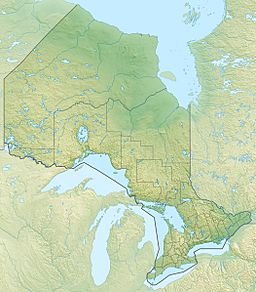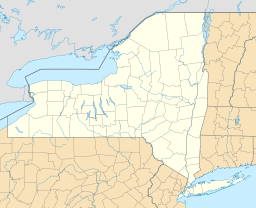Lake Frontenac facts for kids
Quick facts for kids Lake Frontenac |
|
|---|---|
| Location | North America |
| Group | Great Lakes |
| Coordinates | 43°35′N 77°11′W / 43.58°N 77.19°W |
| Lake type | former lake |
| Etymology | Louis de Buade, Comte de Frontenac et de Palluau, GOvernor of New France, 1672-1682. |
| Primary inflows | Laurentide Ice Sheet |
| Basin countries | Canada United States |
| First flooded | 10,000 years before present |
| Max. length | 194 mi (312 km) |
| Max. width | 57 mi (92 km) |
| Surface elevation | 244 ft (74 m) |
Lake Frontenac was a huge ancient lake that existed about 10,000 to 12,000 years ago. It formed in the same area where Lake Ontario is found today. This giant lake was created by the melting of a massive ice sheet that once covered much of North America.
Contents
What Was a Proglacial Lake?
A proglacial lake is a lake that forms right in front of a melting glacier or ice sheet. As the ice melts, the water gets trapped by the ice itself or by hills and valleys. Lake Frontenac was one of these lakes. It was fed by the melting Laurentide Ice Sheet, which was a huge sheet of ice covering much of Canada and parts of the northern United States.
How Lake Frontenac Formed
Imagine a giant wall of ice slowly melting. The water had nowhere to go because the ice blocked its path to the ocean. So, it pooled up, forming a massive lake. Lake Frontenac was much larger and deeper than today's Lake Ontario. It stretched across what is now parts of Canada and the United States.
The Lake's Disappearance
Lake Frontenac didn't last forever. As the climate warmed, the Laurentide Ice Sheet continued to melt and retreat. This melting ice acted like a dam. When the ice dam moved back, new paths opened up for the lake water to flow away.
New Waterways Opened
One important path opened up around the northern side of the Adirondack Mountains. This allowed the water from Lake Frontenac to flow eastward into the basin of what is now Lake Champlain. When this new outlet opened, the water level of Lake Frontenac dropped dramatically. The old outlet near a place called Rome was no longer needed.
The Frontenac Axis
At one point, the ice barrier that held back the lake rested on a geological feature called the Frontenac Axis. This is a ridge of very old rocks. The lake was named "Lake Frontenac" because of this connection to the Frontenac Axis and also after Louis de Buade, Comte de Frontenac et de Palluau, an early governor of New France.
Lake Frontenac's Big Impact
The sudden draining of Lake Frontenac had a huge effect on the Earth's climate. When the lake's massive amount of fresh water suddenly rushed into the Atlantic Ocean, it changed the ocean currents.
The Younger Dryas
Scientists believe this sudden rush of cold fresh water might have triggered a period called the Younger Dryas. This was a time about 12,000 years ago when the Earth, which had been warming up after the last ice age, suddenly got much colder again. This cold snap lasted for about 1,000 years. It shows how interconnected Earth's systems are, and how a big event like a lake draining can have global consequences.



